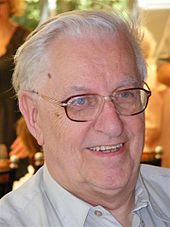Karl-Heinz Rotte
Karl-Heinz Rotte (born October 18, 1933 in Pasewalk , Western Pomerania ) is a German radiologist .
Life
As the son of the doctor Christoph Rotte and his wife Anna, Karl-Heinz Rotte attended school in Pasewalk until he graduated from high school in 1953. In the same year he began studying human medicine at the Humboldt University in Berlin. After the state examination in January 1959, he obtained his doctorate in the same year. med. From 1959 to 1962 he worked in the Prenzlau district hospital. In 1962 Rotte moved to the Robert Rössle Clinic of the German Academy of Sciences in Berlin and worked with Hans Gummel and Stephan Tanneberger . The specialist training took place in the field of radiology under H.-J. Squirrel. In 1967 he became a specialist in X-ray diagnostics and radiation therapy. In 1974 he qualified as a professor in X-ray diagnostics. From 1977 to 1980 he was chief physician in the X-ray department at the Research Institute for Lung Diseases and Tuberculosis (Director: Paul Steinbrück ) in Berlin-Buch . In 1980 he returned to the Robert Rössle Clinic as head of the newly established department for computed tomography.
From 1984 to 1986 he was Chairman of the Department of Diagnostic Radiology at the Kuwait Cancer Control Center (KCCC) in the Emirate of Kuwait.
In 1987 he was appointed professor for diagnostic radiology at the Academy of Sciences of the GDR. From 1986 to 1996 he was head of X-ray diagnostics at the Robert Rössle Clinic, which has been part of Berlin's Humboldt University since 1992. Rotte was a member of the Society for Medical Radiology of the GDR, where it was temporarily also on the board of the German X-ray Society and the Berlin-Brandenburg X-Ray Society.
science
Rotte worked on methods for computer-aided X-ray diagnostics using mathematical-statistical diagnostic models. In practical application, after analyzing chest x- rays, it was able to achieve a significant improvement in the diagnostic accuracy of lung tumors . He first published on this topic in 1974 in the journal Advances in X-Ray and Nuclear Medicine. This work was awarded the Meissner Leibniz Medal in 1975 by the Academy of Sciences and the Walter Friedrich Prize of the Society for Medical Radiology of the GDR in 1976. The developed method could later be used successfully in other tumor locations. Karl-Heinz Rotte's work also focused on the diagnosis of non-tumorous lung diseases and the computed tomographic diagnosis of thoracic, abdominal, bone and soft tissue tumors. Numerous lectures at national and international conferences as well as more than 200 publications, two monographs and several book chapters were part of his scientific activities.
literature
- Biography of Karl-Heinz Rotte. In: Luise Pasternak (ed.): Scientists in the biomedical research center Berlin-Buch 1930-2004. Peter Lang, European Science Publishing House, Frankfurt / Main - Berlin-Buch - Bruxelles - New York - Oxford - Vienna 2004, pp. 191–195.
- Short biography of Karl-Heinz Rotte. In: Kürschner's German Scholars Calendar (Natural Sciences). de Gruyter Verlag, Berlin – New York 2009, p. 3455.
- Short biography of Karl-Heinz Rotte. In Who's Who in the World: Marquis Who's Who. New Providence, New York 2009, p. 2308.
Publications
- Dissertation: On the surgical treatment of inguinal hernias in childhood.
- Habilitation thesis: Differential diagnosis: The radiological diagnosis and differential diagnosis of peripheral bronchial carcinoma using EDP as a diagnostic aid.
- Computer-aided X-ray diagnostics using the example of peripheral lung processes. Akademie-Verlag, Berlin 1977.
- Computed tomography in oncological diagnostics. Akademie-Verlag, Berlin 1990.
Web links
- Literature by and about Karl-Heinz Rotte in the catalog of the German National Library
| personal data | |
|---|---|
| SURNAME | Rotte, Karl-Heinz |
| BRIEF DESCRIPTION | German radiologist |
| DATE OF BIRTH | October 18, 1933 |
| PLACE OF BIRTH | Pasewalk |
